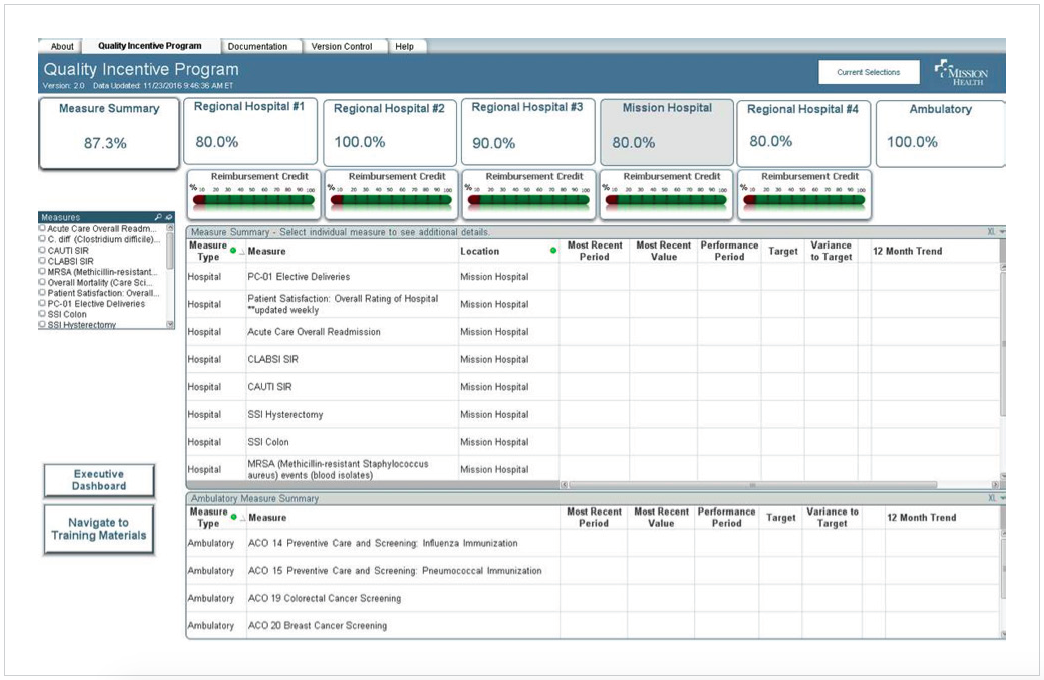Mission Health Receives 100 Percent of At-Risk Dollars in Payer Incentive Program

- Achieved 100 percent of all at-risk dollars.
- 100 percent of the ambulatory metric targets were exceeded, some by as much as 19 percent.
- All five hospitals exceeded targets.
Since 2004, the US healthcare system has annually ranked last relative to 10 other developed nations in quality, access, efficiency, equity, and health outcomes. In an effort to improve the quality of care and patient outcomes in the U.S., the Center for Medicare and Medicaid (CMS) launched a series of quality incentive programs designed to generate a shift from volume to value-based reimbursement. The health insurance industry soon followed their lead, and started writing contracts with hospitals in which a percentage of payment was based on performance on selected quality metrics.
Due to a lack of alignment in the definition and selection of quality metrics across these numerous incentive programs, hospitals and providers must be able to track, report, and improve performance on different versions of similar metrics for various reporting entities, or be faced with decreased reimbursement for the services they provide.
Faced with these challenges, Mission Health leveraged the Health Catalyst Analytics Platform, including their Late-Binding™ Data Warehouse to aggregate the data needed to track the quality measures. With millions of dollars on the line with one particular payer, Mission developed an analytics application to monitor performance on the metrics in that contract. The application was used to analyze whether performance feedback and workflow changes would lead to improved performance on the metrics, thus ensuring that they would maximize reimbursement, while improving care for patients.
Improvement in these metrics reflects that more patients were screened for breast and colorectal cancers, fewer patients contracted healthcare-associated infections, and fewer patients needed to be readmitted.
MEASURING A PROLIFERATION OF PAY-FOR-VALUE METRICS
The U.S. has ranked below 10 other developed nations in multiple dimensions of health performance since 2004. As measured by the Commonwealth Fund, these dimensions cover quality, access, efficiency, equity, and health outcomes.1 The U.S. is attempting to address its performance gaps by shifting reimbursement models from volume- to value-based, which in turn has spawned a plethora of pay-for-value incentives and/or penalty programs in both the governmental and private sectors. Whether driven by a federal agency or commercial payer, each of these programs has its own set of quality metrics and each metric has inclusion and exclusion criteria, which may be different from similarly named metrics included in other programs. This puts an enormous reporting burden on healthcare organizations.
Standardizing the metrics through the recently launched Centers for Medicare and Medicaid Services’ (CMS) Core Quality Measures Collaborative2 is on the horizon, but hospitals and other providers need help simplifying reporting now. More to the point, hospitals and providers must be able to track, report, and improve performance on different versions of similar metrics for various reporting entities now, or be faced with decreased reimbursement for the services they provide.
One such healthcare organization is Mission Health, North Carolina’s sixth-largest health system, with six hospitals, numerous ambulatory sites, a large employed provider group and the largest ACO in North Carolina. Across the Mission enterprise, tens of millions of dollars of reimbursement for care is at risk each year within various pay-for-value programs.
THE HIGH STAKES OF MEETING PERFORMANCE TARGETS
As a participant in both CMS and nongovernmental payer pay-for-value programs, Mission wanted an effective way to monitor and drill down into the measures and performance associated with each incentive program in which it was participating. One such program in 2016-2017 included five ambulatory metrics and 10 hospital-specific measures which varied by each individual hospital. Incentives for this program would be earned by each of the five eligible hospitals, based on achieving or exceeding targeted expectations. Mission decided to use this program as its pilot to driving pay-for-value monitoring into its analytics environment, with the intent to build a model that could be adapted and used for other pay-for-value programs in the future.
However, these monetary incentives alone did not drive the need for change: improvement leaders recognized, and were motivated by, the significant clinical implications of these improvement efforts. If Mission was successful at improving on these quality metrics, patients would clearly receive better care.
The challenges in meeting these metrics were quickly apparent. Lack of visibility into current metric performance in one self-service dashboard, paired with an inability to easily see what was needed at the practitioner and patient level complicated efforts to assess and improve performance. Additionally, some measurement data required manual collection—a frequent need with other value programs—from multiple departments and sources. Not only was this a manual, cumbersome way to aggregate data, it also hampered Mission’s ability to display and analyze the data in a meaningful way. Lastly, delays in receiving information made it difficult to proactively engage patients in recommended interventions, which put further constraints on improving outcomes.
MISSION’S STRATEGY FOR OUTPERFORMING QUALITY GOALS
Mission understood that no single tool or policy or champion would guarantee successful participation in pay-for-value programs with high performance benchmarks. A thoughtful combination of all three, however, could significantly increase the likelihood of success. As such, Mission embarked on a multi-pronged effort to manage tracking and studying numerous metrics with ease.
Leveraging analytics. Mission planned on making use of the capabilities of its Health Catalyst analytics platform, which uses Late-Binding™ Data Warehouse architecture. This particular architecture offers enhanced flexibility in mining data from multiple sources. Since the architecture accepts data from spreadsheets and databases, it provides a simple way to get manually collected data into the enterprise data warehouse (EDW).
A Quality Incentive Program analytics application was developed on top of the EDW by Mission data architects to provide information specific to this payer’s contracted incentive metrics. In building the application, Mission drew on the work of previous improvement projects, pulling data from existing applications whenever possible. This approach expedited development of the new application, making it possible to pull ACO metrics, hospital-specific metrics, and infection prevention metrics for single-location viewing.
Gaining clinician engagement. Mission had learned from other improvement projects, that when presenting a combination of manually collected and automated data to clinicians, it is important for the clinicians to know the source of what they are looking at, why it is important, and what actions they can take to influence it. To that end, Mission set about educating clinicians about the incentive program’s metrics—including when impactful changes were made to them—so that clinicians responsible for helping drive performance could be confident in the data’s accuracy
Putting the plan into action. The next step was to give clinicians visibility into their own performance. Here the analytics application was designed to inform leaders at the hospital, unit, and practice levels of current performance, cumulative performance in the contract period, and variance (positive or negative) to the metric targets (see Figure 1).
The way it works is this: The high-level report card shows trended performance on the measures, with drill down capabilities to the hospital, unit or the practice level, and provides a link to the operational ACO dashboard to see patient lists—which in turn can be used to drive operational performance.
Realizing the practitioners needed data as close to real-time as possible to effectively intervene with their patients, Mission refreshed as soon as it was available in the EDW, including as frequently as daily (from the Medicare Shared Savings Program (MSSP) dashboard). These frequent data updates facilitated rapid cycle adjustments and showed the impact of patient interventions in the following day’s data.

RESULTS
Through a careful mix of data analytics, clinician engagement, and smart execution, Mission received 100 percent of the at-risk payments for this payer. Improvement in these metrics reflects that more patients were screened for breast and colorectal cancers, fewer patients contracted healthcare-associated infections, and fewer patients needed to be readmitted.
- Achieved 100 percent of at-risk dollars.
- 100 percent of the ambulatory metric targets were exceeded, some by as much as 19 percent.
- All five hospitals exceeded targets.
“We knew that we needed to be error-proof during the development of the quality incentive program application, so that clinicians would trust the data affecting the metrics.”
– Terry Richardson
Director Clinical and
Business Analytics
WHAT’S NEXT
The approach taken in developing this application provides a strong foundation that can be used in any improvement activity that has performance metrics. In just one example, Mission has used a similar approach in building support for value-based purchasing, and will also be expanding this model to other pay-for-value programs. Recognizing that the utility of this model is not restricted to quality incentive programs, they are planning to develop similar functionality in support of any effort with operational, and financial metrics/performance targets. Given the successful rates to date, Mission is confident these initiatives will have a significant impact on patient outcomes.
REFERENCES
- Committee for Economic Development. (2016). Top healthcare stories for 2016: Pay-for-performance.
- Centers for Medicare & Medicaid Services. (2016). Core measures.
ABOUT HEALTH CATALYST
Health Catalyst is a mission-driven data warehousing and analytics company that helps healthcare organizations of all sizes perform the clinical, financial, and operational reporting and analysis needed for population health and accountable care. Our proven enterprise data warehouse (EDW) and analytics platform helps improve quality, add efficiency and lower costs in support of more than 50 million patients for organizations ranging from the largest US health system to forward-thinking physician practices.
For more information, visit healthcatalyst.com, and follow us on Twitter, LinkedIn, and Facebook.
This website stores data such as cookies to enable essential site functionality, as well as marketing, personalization, and analytics. By remaining on this website you indicate your consent. For more information please visit our Privacy Policy.